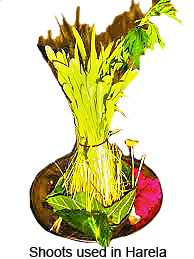Held on : 16th July
Harela Festival (mela) is an annual local festival of Kumaun region in Uttarakhand.  The mela is celebrated to welcome the rainy season, new harvest and to commemorate the wedding of Lord Shiva. The fair is typically organised from 16th to 21st July at Ramlila Ground of Bhimtal. The term Harela stands for ‘Yellow Leaves’ which grow from seven types of grains which are sowed few days prior to the festival. The term also refers to general greenery all around and especially greenery of the crops due to the monsoon season. Modern times and its practices have overtaken such traditional practices, Harela festival is no exception. It is losing its importance year by year and a lot needs to be done to preserve it. Uttrakhand is often known as land of festivals and as land of temples and if such a festival loses its importance then a unique festivity will be lost which has both political and cultural significance.
The mela is celebrated to welcome the rainy season, new harvest and to commemorate the wedding of Lord Shiva. The fair is typically organised from 16th to 21st July at Ramlila Ground of Bhimtal. The term Harela stands for ‘Yellow Leaves’ which grow from seven types of grains which are sowed few days prior to the festival. The term also refers to general greenery all around and especially greenery of the crops due to the monsoon season. Modern times and its practices have overtaken such traditional practices, Harela festival is no exception. It is losing its importance year by year and a lot needs to be done to preserve it. Uttrakhand is often known as land of festivals and as land of temples and if such a festival loses its importance then a unique festivity will be lost which has both political and cultural significance.
Harela festival is celebrated in two different ways on two different occasions as mentioned below:
Harela festival traditional practices and activities
- Harela Festival Chaitra Celebrations – Chaitra is the name of traditional Hindu month which corresponds with the months of March-April as per the Gregorian calendar. On the first of the navaratris (nine day fasting period) in the month of Chaitra, women sow seven or five types of grains some of which include barley, lintel, mustard and wheat. These are grown in pots inside the room, using small baskets filled with earth. In some parts the sowing is done is done ceremoniously either by the head of the family or the family priest. After the prayer the water is sprinkled all around. The germination of these grains symbolizes the future harvest and beginning of new life of the nature. The shoots of the crops also indicates the qualities or defects of the seeds a farmer has in his store. On the tenth day, the yellow leaves, called Harela, and the shoots are cut and adorned on the head or tucked behind the ears to mark the occasion. One day before the actual celebration of the festival, a mock weeding is organise with small wooden hoes (farming tools). On the day of the festival painted images of Shiva, Parvati and their off springs are prepared and worshipped. Pocket money to the young girls of the family is also distributed on this day.
- Harela Festival Shravan Celebrations - Shravan is the name of traditional Hindu month which corresponds with the months of July-August as per the Gregorian calendar. The shravan festivities are more popular than the chaitra one’s as the month corresponds with the rainy season and wedding of Lord Shiva and Parvati. The months of July and August are the monsoon months and it is an appropriate occasion to celebrate the crop booming months. On this day people create small clay/red soil idols (dikaras) of Ganesh, Gauri, Maheshwar and others associated with Lord Shiva. These idols are worshipped and ceremonial prayers are organised in reverence of Lord Shiva in various temples. This is an off day for all including the overworked bullocks. People adorn the blades of freshly cut Harela (shoots of sowed crops) on their heads and send them to their relatives and friends as well.
History of Harela Mela
Harela Mela celebration is over 100 years old. Before independence traders used to carry their trade by transporting crops and other materials from places like Bareilly to sell here. People from Padampuri, Gunialeakh, Mukteshwar, Okhlakanda etc. would travel here to buy the various products sold here. Thus it was not just a cultural hub but a business centre as well. Earlier, the venue of the fair was Lilavati Pant College (danth) because this was the city centre. However after 1980 due to insufficient space the venue was shifted to Ramlila ground at Mallital. The fair was also of less duration as compared to the prevalent one (as of 2013). The fair was earlier organised for 2 days but these days it is observed for a period of 5 days. Even the organisation management has changed, earlier the Harela Khel evum Sanskritik Manch used to organise it but now it is organised by Nagar Panchayat.
The fair also had political significance as various political parties would organise their stalls to increase awareness about their parties and their objectives. Before independence it was a meeting ground for freedom fighters of the nation. Even after independence the venue continued to be the platform of political activities. Politicians like Narayan Dutt Tiwari started their initial career by attending the political programmes organised at the fair. Partap Singh Bisht and few local elders administered the fair and Sanwal ji along with Moti Ram Pandey ji contributed in the organisation of the fair.
Holiday Status – It is a local / regional holiday.
